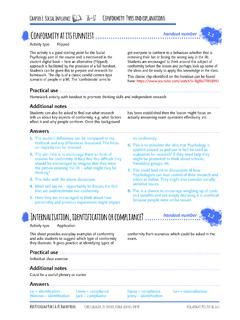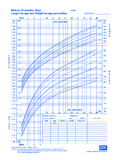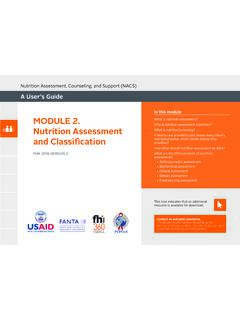Transcription of Computers hinder children’s learning handout number 6
1 Chapter 6: Research methods Introduction Computers hinder children's learning handout number Activity type Starter This handout can be used right at the start of the year 1 although they do not have the terminology (yet) they course to get students thinking about the characteristics usually can see what is wrong. of good research'. The beauty of the exercise is that Practical use Paired class activity or individual homework Additional notes You can, of course, then give them the terms to link to their intuitive understanding. Answers Some suggested issues Ethical issues, lack of parental consent, lack of consent from the headteacher, confidentiality of data (exam grades being used for research purposes).
2 Extraneous variables not accounted for the teacher didn't ask what the computer is being used for! Nor did she get corroborative evidence, from the parents. Sampling the school is probably not representative and as such the results cannot be generalised to other schools and pupils. Her sampling was not random (choosing a few naughty ones). Dependent variable are exam grades the best measure? AQA Psychology Year 1 & AS Teacher Notes Cara Flanagan, Jo Haycock, Diana Jackson-Dwyer Illuminate Publishing 2015. Chapter 6: Research methods 166 167 Experimental Method Hypotheses: Directional or non-directional? handout number Activity type Consolidation A straightforward task identifying whether general The handout covers both experimental and correlational hypotheses are directional or non-directional.
3 The hypotheses. handout summarises the difference between the two There is an extension task concerning what determines and offers a precautionary warning against jumping to what type of hypothesis is used. conclusions based on expectation. Practical use Individual: homework Additional notes When discussing the reason for directional/non- hypotheses you would use for various theories (capacity directional it may be useful to go back to the topic of STM, chunking, interference theory of forgetting, etc.). of memory as a revision exercise and discuss what Answers ND=non-directional, D=directional 1 = ND, 2 = D, 3 = ND, 4 = D, 5 = D, 6 = D, 7 = D, 8 = ND, 9 = ND, 10 = ND. Whether a directional or non-directional hypothesis When there is little or no research or the findings is chosen depends on knowledge from previous are ambiguous, it is best to use a non-directional research.
4 If the findings of previous research suggest hypothesis. the direction of the findings use directional hypothesis. IV and DV Identification handout number Activity type Consolidation This is an exercise on identifying the IV and DV. You There is an additional exercise to reinforce the previous should emphasise to students the need to be precise. topic deciding if the hypotheses are directional or non- directional. Practical use Individual homework or classwork. If done in class, could be assessment. Additional notes This is a good time to ensure that students learn how to spell independEnt and dependEnt! Answers ND=non-directional, D=directional 5. IV = sex (man or woman), DV = speed of driving.
5 D. 1. IV = auditory or visual stimulus, 6. IV = amount of sleep, DV = amount of learning in DV = reaction time. ND ten-year-old boys . ND. 2. IV = presence or absence of drug A, 7. IV = whether babies are under or over 9 months DV = amount remembered. ND old, DV = whether or not searching occurs. D. 3. IV = red or blue rag (not just colour), 8. IV = social class, DV = score. ND. DV = number of charges made by the bull. D. 9. IV = whether items are chunked or unconnected, 4. IV = position in family, first or subsequent, DV = number of items remembered. D. DV = age at which first words spoken. D. AQA Psychology Year 1 & AS Teacher Notes Cara Flanagan, Jo Haycock, Diana Jackson-Dwyer Illuminate Publishing 2015.
6 Chapter 6: Research methods 166 167 Experimental method 10. IV = time of day, DV = (level of) alertness. ND 12. IV = whether or not rats are handled., DV = time taken to learn the maze. D 11. IV = whether conditions are noisy or quiet, DV = number of words learnt. D. Operationalisation of variables handout number Activity type Consolidation This is an exercise on operationalising variables as well as writing both directional and non-directional hypotheses. Practical use Individual, classwork or homework Additional notes It may be useful and time saving on marking for students could discuss the appropriateness of various ways of to swap papers and mark each other's answers. They operationalising the different variables.
7 Answers Obviously there are many ways of operationalising 3. To see if the age of the child affects how much variables and as long as they are a means of precisely rough and tumble play they engage in. measuring the variables that is acceptable. Age 3 5 years and 10 11 years (any suitable Examples time span). 1. To see if the amount of work students do is Rough and tumble play quantity of play affected by when they do it: involving physical contact accompanied by smiling or laughing (observations made using Amount of work score on a test or a set of behavioural categories and counted). questions. 4. To see whether spending time on social media Time any two time slots such as 9 10 8 9. affects people's sociability.
8 Time on social media average daily or weekly 2. To see if the amount of stress people are under time spent on it. affects their health. Sociability the average amount of time per day Scores on a stress questionnaire such as the life (or weekly) spent with friends. events scale. 5. To see whether an audience affects how hard a bee Health number of days off sick (if working);. will work. scores on a health questionnaire. Audience put the bee in a see-through hive with or without other bees on the outside. Work the amount of honeycomb they build;. the amount of time spent cleaning the hive; the amount of honey they take to the queen. Extension activity Internal validity is defined as the extent to which what may think of various measures of memory in which lists is measured reflects what a study aims to measure.
9 For of words are recalled how valid is this as a measure example, a measure of intelligence which measures the of everyday memory? They could use examples from head circumference is obviously not a valid measure (a memory experiments they have studied. ridiculous example serves to make the point). Students validity is on A level but not AS specification. AQA Psychology Year 1 & AS Teacher Notes Cara Flanagan, Jo Haycock, Diana Jackson-Dwyer Illuminate Publishing 2015. Chapter 6: Research methods 168 169 Control of variables Demand characteristics and investigator effects handout number Activity type Consolidation This is an exercise in which students first suggest cues suggest ways in which they may be affected by demand that may result in demand characteristics and are characteristics and investigator effects.
10 Then given four investigations in which they have to Practical use Individual: homework or classwork Additional notes Demand characteristics are ones that students often find difficult so it well worth spending some time on ensuring that they are able to utilise the term effectively. Answers Possible cues resulting in demand characteristics: Investigator effects: the investigator may expect boys and girls to behave differently with respect to co- The actual communication during the study: the operation ( , that girls will be more co-operative instructions and any implicit clues from non-verbal than boys ) and this may affect what behaviour is communication. interpreted as co-operative and what is not.












